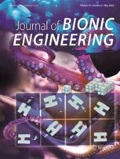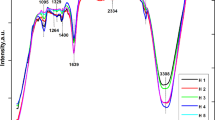Abstract
Tissue-engineered bone scaffolds provide temporary mechanical support for bone tissue growth. Mechanical stimuli are transferred to seeded cells through the scaffold structure to promote cell proliferation and differentiation. This paper presents a numerical investigation specifically on bone and cartilage tissue differentiation with the aim to provide a theoretical basis for scaffold design and bone defect repair in clinics. In this study, the scaffold structures were established on the basis of cancellous bone microarchitectures. For finite element simulations, inlet velocity and compressive strain were applied under in vitro culture conditions. The influences of this scaffold morphology and macro-level culture conditions on micro-mechanical stimuli at scaffold surfaces were investigated. Correlations between the microarchitectural parameters and the mechanical parameters, as well as the cell differentiation parameters were analyzed. Highly heterogeneous stress distributions were observed on the scaffolds with irregular morphology. Cell differentiation on the scaffold was more sensitive to the inlet velocity than the axial strain. In addition, cartilage differentiation on the scaffolds with structures comprising more plate-like trabeculae was more pronounced than on those with more rod-like trabeculae. This paper is helpful to gain more insight into the mechanical environments under in vitro culture conditions that approximate the in vivo mechanical environments of Bone Marrow Stromal Cells (BMSCs).
Similar content being viewed by others
References
Greenwald A S, Boden S D, Goldberg V M, Khan Y, Laurencin C T, Rosier R N. Bone-graft substitutes: Facts, fictions, and applications. The Journal of Bone & Joint Surgery, 2001, 83A, 98–103.
Giannoudis P V, Dinopoulos H, Tsiridis E. Bone substitutes: An update. Injury, 2005, 36, 20–27.
Williams J M, Adewunmi A, Schek R M, Flanagan C L, Krebsbach P H, Feinberg S E, Hollister S J, Das S. Bone tissue engineering using polycaprolactone scaffolds fabricated via selective laser sintering. Biomaterials, 2005, 26, 4817–4827.
Martinez-Vazquez F J, Cabanas M V, Paris J L, Lozano D, Vallet-Regi M. Fabrication of novel Si-doped hydroxyapatite/ gelatine scaffolds by rapid prototyping for drug delivery and bone regeneration. Acta Biomaterialia, 2015, 15, 200–209.
Deng Y, Zhao K, Zhang X F, Hu P, Chen G Q. Study on the three-dimensional proliferation of rabbit articular cartilage-derived chondrocytes on polyhydroxyalkanoate scaffolds. Biomaterials, 2002, 23, 4049–4056.
Yoon S J, Park K S, Kim M S, Rhee J M, Khang G, Lee H B. Repair of diaphyseal bone defects with calcitriol-loaded PLGA scaffolds and marrow stromal cells. Tissue Engineering, 2007, 13, 1125–1133.
Thimm B W, Unger R E, Neumann H G, Kirkpatrick C J. Biocompatibility studies of endothelial cells on a novel calcium phosphate/SiO(2)-xerogel composite for bone tissue engineering. Biomedical Materials, 2008, 3, 015007.
Hutmacher D W, Sittinger M, Risbud M V. Scaffold-based tissue engineering: Rationale for computer-aided design and solid free-form fabrication systems. TRENDS in Biotechnology, 2004, 22, 354–362.
Sanz-Herrera J A, Garcia-Aznar J M, Doblare M. On scaffold designing for bone regeneration: A computational multiscale approach. Acta Biomaterialia, 2009, 5, 219–229.
Karageorgiou V, Kaplan D. Porosity of 3D biomaterial scaffolds and osteogenesis. Biomaterials, 2005, 26, 5474–5491.
Murphy C M, Haugh M G, O'Brien F J. The effect of mean pore size on cell attachment, proliferation and migration in collagen-glycosaminoglycan scaffolds for bone tissue engineering. Biomaterials, 2010, 31, 461–466.
Nazemi K, Azadpour P, Moztarzadeh F, Urbanska A M, Mozafari M. Tissue-engineered chitosan/bioactive glass bone scaffolds integrated with PLGA nanoparticles: A therapeutic design for on-demand drug delivery. Materials Letters, 2015, 138, 16–20.
Chan B P, Leong K W. Scaffolding in tissue engineering: General approaches and tissue-specific considerations. European Spine Journal, 2008, 17, 467–479.
Martin I, Wendt D, Heberer M. The role of bioreactors in tissue engineering. Trends in Biotechnology, 2004, 22, 80–86.
Farzadi A, Waran V, Solati-Hashjin M, Rahman Z A A, Asadi M, Abu Osman N A. Effect of layer printing delay on mechanical properties and dimensional accuracy of 3D printed porous prototypes in bone tissue engineering. Ceramics International, 2015, 41, 8320–8330.
Lacroix D, Chateau A, Ginebra M P, Planell J A. Mi-cro-finite element models of bone tissue-engineering scaffolds. Biomaterials, 2006, 27, 5326–5334.
Prendergast P J, Huiskes R, Soballe K. Biophysical stimuli on cells during tissue differentiation at implant interfaces. Journal of Biomechanics, 1997, 30, 539–548.
Byrne D P, Lacroix D, Planell J A, Kelly D J, Prendergast P J. Simulation of tissue differentiation in a scaffold as a function of porosity, Young’s modulus and dissolution rate: Application of mechanobiological models in tissue engineering. Biomaterials, 2007, 28, 5544–5554.
Olivares A L, Marshal E, Planell J A, Lacroix D. Finite element study of scaffold architecture design and culture conditions for tissue engineering. Biomaterials, 2009, 30, 6142–6149.
Checa S, Prendergast P J. Effect of cell seeding and mechanical loading on vascularization and tissue formation inside a scaffold: A mechano-biological model using a lattice approach to simulate cell activity. Journal of Biomechanics, 2010, 43, 961–968.
Stops A J F, Heraty K B, Browne M, O'Brien F J, McHugh P E. A prediction of cell differentiation and proliferation within a collagen-glycosaminoglycan scaffold subjected to mechanical strain and perfusive fluid flow. Journal of Biomechanics, 2010, 43, 618–626.
Sandino C, Lacroix D. A dynamical study of the mechanical stimuli and tissue differentiation within a CaP scaffold based on micro-CT finite element models. Biomechanics and Modeling in Mechanobiology, 2011, 10, 565–576.
Yang S F, Leong K F, Du Z H, Chua C K. The design of scaffolds for use in tissue engineering. Part 1. Traditional factors. Tissue Engineering, 2001, 7, 679–689.
Fan R X, Gong H, Qiu S, Zhang X B, Fang J, Zhu D. Effects of resting modes on human lumbar spines with different levels of degenerated intervertebral discs: A finite element investigation. BMC Musculoskeletal Disorders, 2015, 16, https://doi.org/10.1186/s12891-015-0686-z.
Fang J, Gong H, Kong L Y, Zhu D. Simulation on the internal structure of three-dimensional proximal tibia under different mechanical environments. Biomedical Engineering Online, 2013, 12, https://doi.org/10.1186/1475-925X-12-130.
Grimm M J, William J L. Measurements of permeability in human calcaneal trabecular bone. Journal of Biomechanics, 1997, 30, 743–745.
Gibson L J. Biomechanics of cellular solids. Journal of Biomechanics, 2005, 38, 377–399.
Beaupre G S, Hayes W C. Finite-element analysis of a 3-dimensional open-celled model for trabecular bone. Journal of Biomechanical Engineering, 1985, 107, 249–256.
Boschetti F, Raimondi M T, Migliavacca F, Dubini G. Prediction of the micro-fluid dynamic environment imposed to three-dimensional engineered cell systems in bioreactors. Journal of Biomechanics, 2006, 39, 418–425.
Coughlin T R, Niebur G L. Fluid shear stress in trabecular bone marrow due to low-magnitude high-frequency vibration. Journal of Biomechanics, 2012, 45, 2222–2229.
Zhang X B, Gong H. Simulation on tissue differentiations for different architecture designs in bone tissue engineering scaffold based on cellular structure model. Journal of Me-chanics in Medicine and Biology, 2015, 15, 1550028.
Hollister S J, Brennan J M, Kikuchi N. A homogenization sampling procedure for calculating trabecular bone effective stiffness and tissue-level stress. Journal of Biomechanics, 1994, 27, 433–444.
Nauman E A, Fong K E, Keaveny T M. Dependence of intertrabecular permeability on flow direction and anatomic site. Annals of Biomedical Engineering, 1999, 27, 517–524.
Kane R J, Weiss-Bilka H E, Meagher M J, Liu Y X, Gargac J A, Niebur G L, Wagner D R, Roeder R K. Hydroxyapatite reinforced collagen scaffolds with improved architecture and mechanical properties. Acta Biomaterialia, 2015, 17, 16–25.
Vikingsson L, Claessens B, Gomez-Tejedor J A, Ferrer G G, Ribelles J L G. Relationship between micro-porosity, water permeability and mechanical behavior in scaffolds for cartilage engineering. Journal of the Mechanical Behavior of Biomedical Materials, 2015, 48, 60–69.
Adachi T, Osako Y, Tanaka M, Hojo M, Hollister S J. Framework for optimal design of porous scaffold micro-structure by computational simulation of bone regeneration. Biomaterials, 2006, 27, 3964–3972.
Syahrom A, Kadir M R A, Harun M N, Ochsner A. Permeability study of cancellous bone and its idealised structures. Medical Engineering & Physics, 2015, 37, 77–86.
Wendt D, Marsano A, Jakob M, Heberer M, Martin I. Os cillating perfusion of cell suspensions through three-dimensional scaffolds enhances cell seeding efficiency and uniformity. Biotechnology and Bioengineering, 2003, 84, 205–214.
Sandino C, Planell J A, Lacroix D. A finite element study of mechanical stimuli in scaffolds for bone tissue engineering. Journal of Biomechanics, 2008, 41, 1005–1014.
Cartmell S H, Porter B D, Garcia A J, Guldberg R E. Effects of medium perfusion rate on cell-seeded three-dimensional bone constructs in vitro. Tissue Engineering, 2003, 9, 1197–1203.
Porter B, Zauel R, Stockman H, Guldberg R, Fyhrie D. 3-D computational modeling of media flow through scaffolds in a perfusion bioreactor. Journal of Biomechanics, 2005, 38, 543–549.
Ban Y, Wu Y Y, Yu T, Geng N, Wang Y Y, Liu X G, Gong P. Response of osteoblasts to low fluid shear stress is time dependent. Tissue Cell, 2011, 43, 311–317.
Bancroft G N, Sikavitsast V I, van den Dolder J, Sheffield T L, Ambrose C G, Jansen J A, Mikos A G. Fluid flow increases mineralized matrix deposition in 3D perfusion culture of marrow stromal osteloblasts in a dose-dependent manner. Proceedings of the National Academy of Sciences, 2002, 99, 12600–12605.
Milan J L, Planell J A, Lacroix D. Computational modellingof the mechanical environment of osteogenesis within a polylactic acid-calcium phosphate glass scaffold. Biomaterials, 2009, 30, 4219–4226.
Fassina L, Visai L, Asti L, Benazzo F, Speziale P, Tanzi M C, Magenes G. Calcified matrix production by SAOS-2 cells inside a polyurethane porous scaffold, using a perfusion bioreactor. Tissue Engineering, 2005, 11, 685–700.
Pearce A I, Richards R G, Milz S, Schneider E, Pearce S G. Animal models for implant biomaterial research in bone: A review. European Cells & Materials, 2007, 13, 1–10.
Acknowledgment
This work is supported by the National Natural Science Foundation of China (Nos. 81471753, 11432016 and 11322223), the project from Science and Technology Department of Jilin Province (20160101297JC), the project from Department of Education Science and Technology of Jilin Province (JJKH20180560KJ) and the grant from China Scholarship Council.
Author information
Authors and Affiliations
Corresponding author
Rights and permissions
About this article
Cite this article
Zhang, X., Gong, H., Fan, R. et al. Comparative Study between Bone Tissue Engineering Scaffolds with Bull and Rat Cancellous Microarchitectures on Tissue Differentiations of Bone Marrow Stromal Cells: A Numerical Investigation. J Bionic Eng 15, 924–938 (2018). https://doi.org/10.1007/s42235-018-0079-8
Published:
Issue Date:
DOI: https://doi.org/10.1007/s42235-018-0079-8




